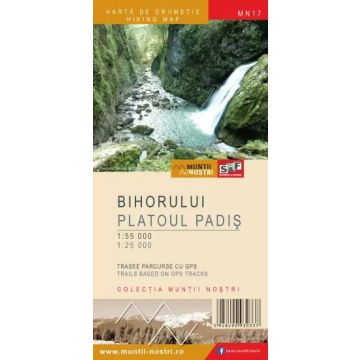Wanderkarte MN-17, Bihorului, Platoul Padiș 1:55.000/1:25.000
Rumänische Westkarpaten

Tags
The Bihor-Padis Mountains are located in the central part of the Apuseni Mountains, bordered by the Vladeasa Mountains to the north, the Gilau Mountains to the north-east, Muntele Mare to the east, the Metaliferi Mountains to the south and south-east, the Codru Moma Mountains to the west, and Beius Depression to the northwest.
There are numerous gorges, caves, sinkholes and karst springs, this area of the country being representative for karst topography. The highest elevation is reached on Curcubata Mare Peak, 1849 m, also known as Bihor Peak. Besides the highest peak, other peaks attracting the attention of hiking enthusiasts are: Curcubata Mica Peak, Piatra Graitoare Peak, Mount Gaina Cruce.
There are also several famous natural attractions in this area, such as: Ponor Fortress, Scarisoara Ice Cave, Bears’ Cave, Vartop Ice Cave, Radeasa Fortress, the Lost World Karst Plateau or the Rusty Pit. Other less known sights that can be visited are: Ionel's Gate Cave, Bihor Gates Cave, Ordancusa Gorge, Varciorog Waterfall or Patrahaitesti Waterfall.
The map of Bihorului Mountains (MN17) is the 17th map of the new Muntii Nostri collection.
The map was edited using the latest mapping techniques and it was printed on moisture resistant paper. It is easy to read and simple to use due to the mapping styles, specific to Schubert & Franzke company, and as a result of practical information structuring. It is handy and everything is exactly where it should be. The map is useful for both hiking enthusiasts and professionals.
The Padis Plateau area was digitized at a more detailed scale: 1:25.000.
All the trails have been recorded in the field using a GPS. They are described in detail in both Romanian and English, some trails having representative images attached to them. Each trail has a technical box containing: trail marking checked in the field, trail route, profile with major landmarks, data on difficulty, length, total ascent, total descent, round-trip time, practicability depending on the season and so on. The map also contains the UTM grid, a projected coordinate metric system useful in the quick measurement of distances on the map. Shading and contour lines highlight the landscape and facilitate orientation.
Weight:
81 g
Publisher:
Series:
Scale:
1:55.000
Product Type:
Books
Language:
English, Romanian
EAN:
5948490930672
Year of publication:
2023
Write Your Own Review
No manufacturer information and safety instructions available yet.








